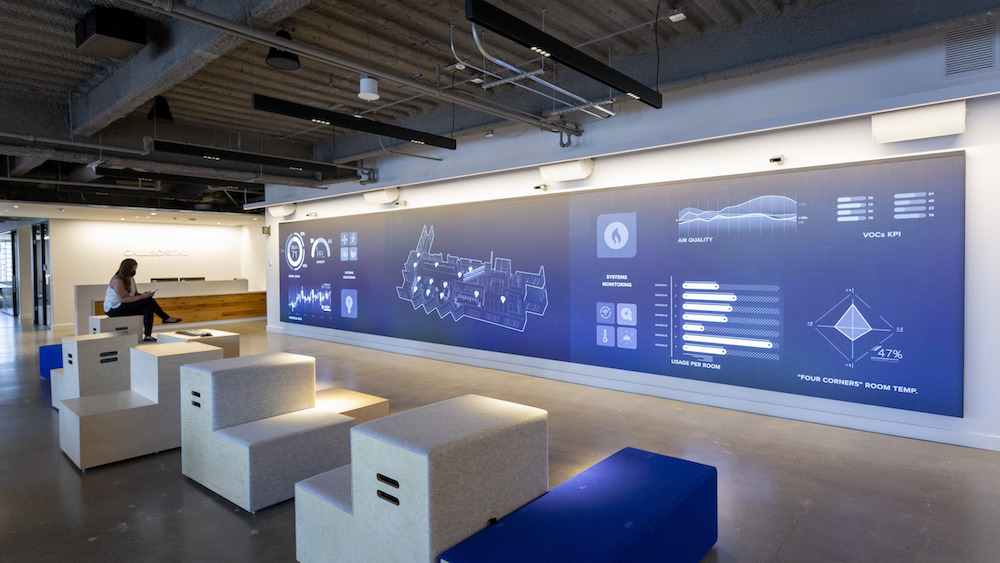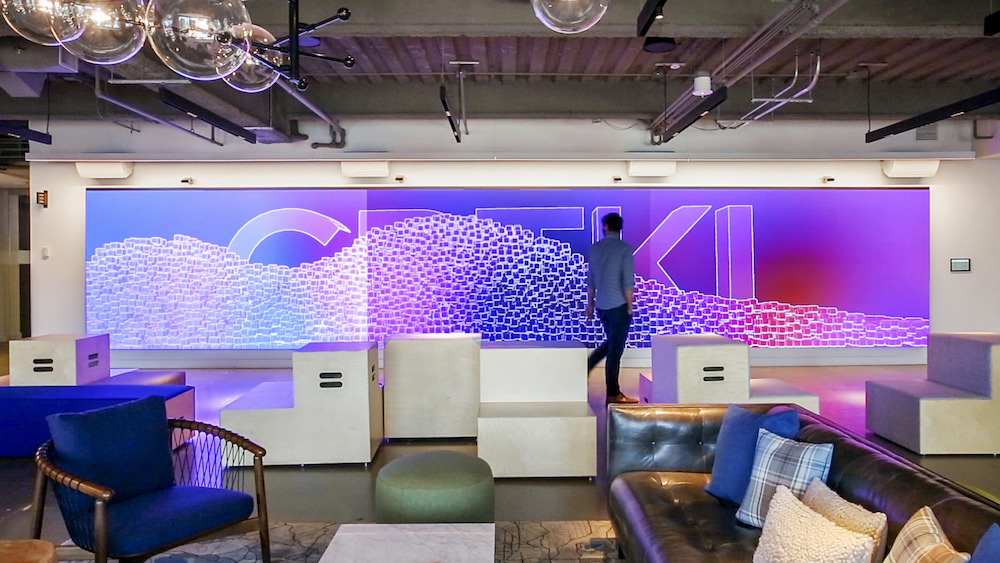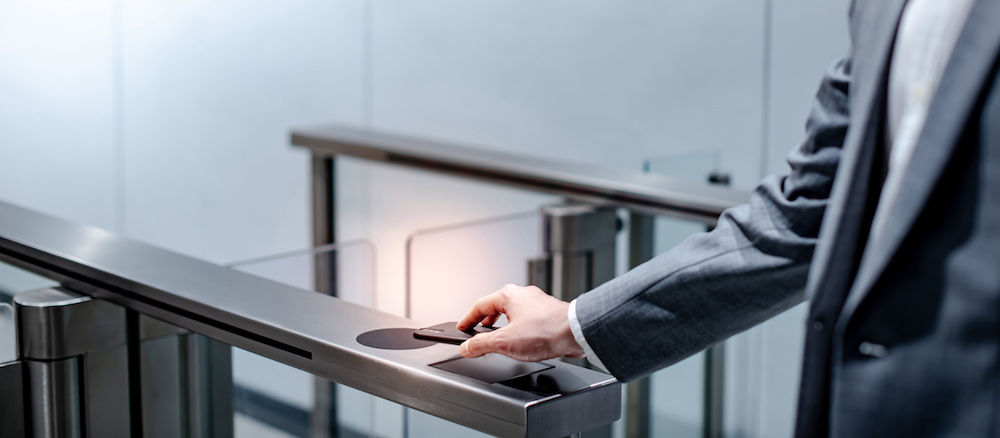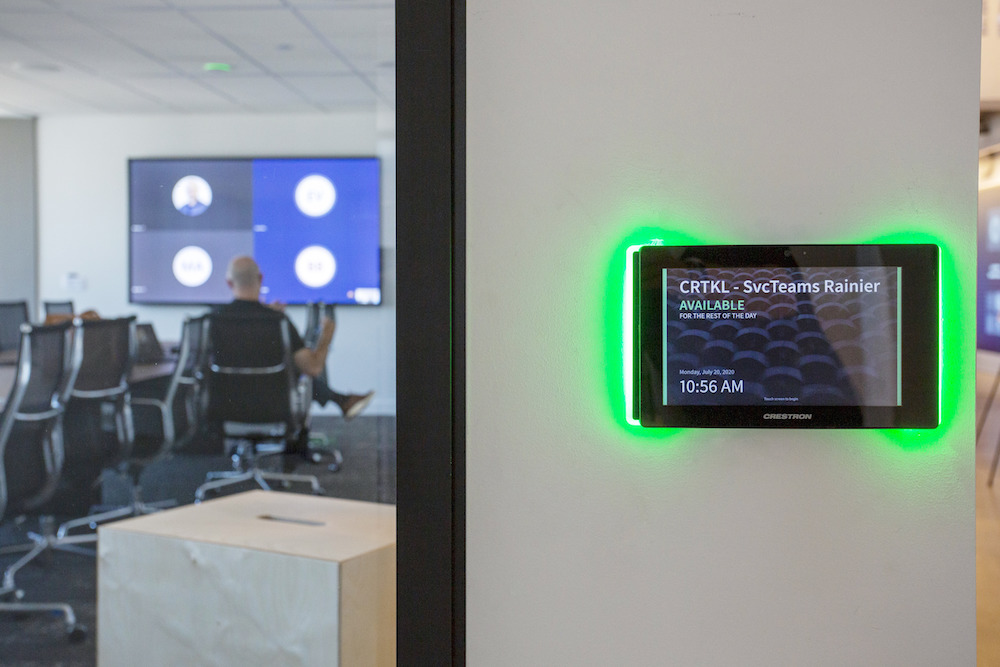Ken Bayern and Dena Yamaguchi of CallisonRTKL share how workplace technology will evolve in the wake of the COVID-19 pandemic.
CallisonRTKL Seattle lobby digital screen
As we look to the future of the workplace, and more specifically, the office experience, post-pandemic, it’s clear that technology will play a pivotal role in what these spaces will offer, look like, and how they will operate. Both in-office systems specifically geared towards collaboration, as well as our own personal devices that we use daily, are going to become key tools in not only drawing employees back into the office, but also in ensuring employee safety and well-being. These systems will also be essential to preserving productivity and efficiency in the office in a time when companies have realized that fully remote operations are a possibility. Firms like CallisonRTKL are taking a holistic approach to integrating workplace technology, ensuring that it contributes to an environment that is collaborative, safe, effective, and equipped for the future.
BYOD: BRING YOUR OWN DEVICE
COVID-19 has led to more technology enablement than ever before, by necessity. As a result, personal mobile devices will undoubtedly become more integrated into the day-to-day workplace experience. Individual users will not only use them to communicate, but to connect with smart systems built within the workplace. Through this integration, personal devices will aid in securing a conference room or a desk space, ordering food for a meeting—really anything needed to prep for a big meeting can now be accomplished from the palm of your hand. These applications will save employees time as well while increasing their productivity.
Furthermore, with the newest office technologies, employees can use their phones to scan into the office, activate, and unlock necessary AV equipment, access their destination dispatch for building elevators, receive important real-time announcements, check real-time parking space availability, and use them for campus wayfinding capabilities—all things that would have required employees to touch surfaces in the past. The seamless way that personal devices dovetail with scheduling software that already exists in the marketplace makes these innovations a no-brainer as people start to transition back to the in-person office.
As wellness continues to be top of mind both at home and in the workplace, personal devices can also be used as an important tool as employees’ well-being is top priority now more than ever. Notifications can be sent out to employees via their phone reminding them to stand up and stretch, take a five-minute mental break, as well as to notify staffers about any other wellness initiatives being implemented throughout the office. This system can also be used to notify employees about the status of office sanitation protocols, giving them much needed peace of mind during a stressful time.
Screen capture from video of Seattle lobby of CRTKL
SEAMLESS VIDEO CONFERENCING
Both on our personal devices and those that are larger, collaborative video technology has been one of the biggest heroes of the pandemic era. Hardly a day goes by where we are not interfacing on Zoom, Microsoft Teams, Google Meet, or any of the other various conferencing technologies on the market. As people return to the office, enhanced meeting capabilities are going to be of utmost importance. Seamless conferencing is crucial, as is being able to key in people who are not in the office when you are. Offices need to transform into a virtual-in-person hybrid without missing a beat—a huge cultural shift aided in large part by workplace technology.
Effective workplaces now and in the future need efficient collaboration technologies that foster seamless conversations both on-site and at home. Ideally, employees will have access to virtual conferencing that is nearly identical to what they have at home, presenting minimal technical difficulty when dialing in. Mirroring the work-from-home experience not only decreases potential technical issues while allowing for attendees to seamlessly be in the office or working remotely while collaborating with one another without batting an eye.
Businessman hand with business wear using smartphone to open automatic gate machine in office building. Working routine concept
SUSTAINABILITY AND WELLNESS
Technology also plays an important role in workplace sustainability. Strategically implemented smart systems can gather important data on green performance, informing company decisions for a more environmentally friendly future. Furthermore, technology can be used to easily adjust HVAC filtration and air flow, control sensors improve comfort and operational efficiency and moderate other systems that contribute to an office’s carbon footprint. Using 3D digital replicas of workspaces can create impactful sensory data that shows real-time visualization and analysis of facilities, and stores static construction and manufacture documentation on a single source. These green “digital twins” can be instrumental in helping make important decisions about the workspace’s future.
In addition to valuable sustainability initiatives, technology also contributes to important wellness systems that are integral to the current and future employee experience. For example, lighting that mimics natural light patterns to regulate workers’ circadian rhythms, and tech that monitors various occupancy sensors and wall switches, alerting employees when touch becomes too frequent so they can calibrate accordingly. Sensors to measure data for temperature, humidity, CO2, VOC, and sound levels that are displayed on common area digital wellness dashboards promote a culture of care and wellness. As physical and mental health remain priorities for employees and their employers, having a workplace that can respond quickly and with minimal touch to these needs seamlessly will be an essential factor in a long-lasting, sustainable workplace moving forward.
CallisonRTKL Seattle conference room touchpad
LOOKING TO THE FUTURE
The way we work is constantly changing and technology plays a pivotal role in that evolution. The workplace of the future, whatever that may ultimately look like, will inevitably be driven by people and fueled by technology—and with factors like COVID-19 making employers think of new ways to navigate the workplace, having technological solutions that work seamlessly with the office of the future is more important than ever. The workspaces of today and tomorrow must be designed around a user-centric approach—one that prioritizes and invests in the employees’ needs and enables individual productivity and efficiency. Technology and physical spaces must enter into a symbiotic relationship in order to deliver the best experience for both the employee and the company as a whole.








